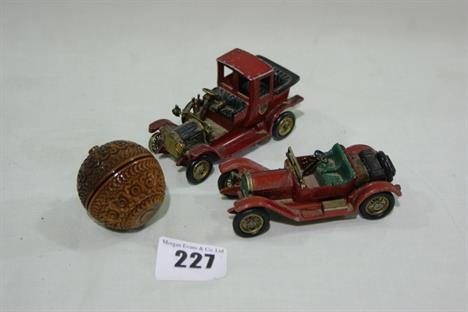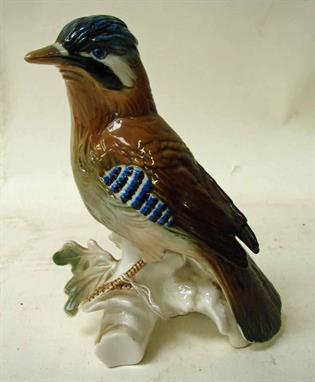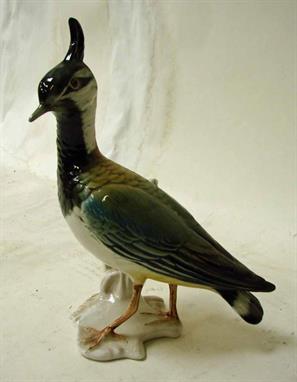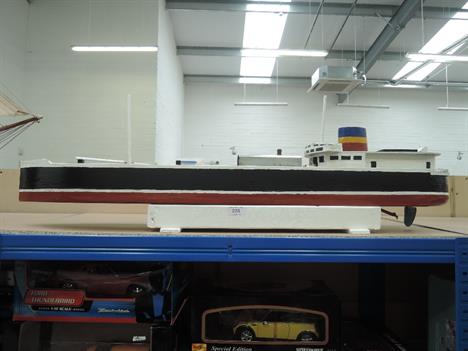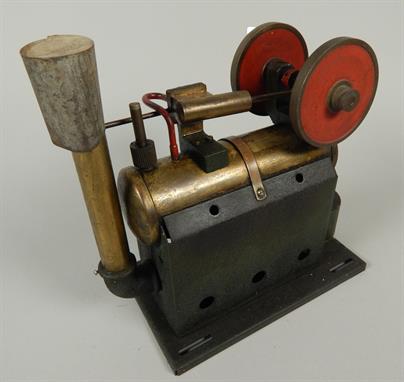1969 Morris Mini panel van Vin no. YJBAV4R1798 Engine no. 10YTUH20609 A British icon of the 1960s, the Mini was voted the second most influential car of the 20th century (behind the Ford Model T). The appeal of the Morris Minor is so strong that for many people the mere mention of the name evokes nostalgic memories. A favourite with young and old, some 5.3 million Minis were manufactured and sold, making it the most popular British car ever produced. The first prototype appeared in the experimental workshops at Cowley in early 1943, in time for when the war was eventually won and a new small car was needed to replace the Series E Morris. Left in the talented young hands of Alec Issigonis, his sketch-pad drawings depicted a ‘new generation’ of small car, with a highly unitary body-shell and uniquely small wheels. Officially announced to the public in August 1959, the Mini was marketed under two main brand names, Austin and Morris, until 1969 when it became a marque in its own right. Manufactured at the Victoria Park / Zetland British Motor Corporation factory in Sydney, the Mini Mark had three major UK updates – the Mark II, the Clubman and the Mark III. Slow at the outset, Mark I sales strengthened across most of the model lines in the 1960s, and production totalled 1,190,000. The Mini’s distinctive design features two-doors and a space saving front-wheel drive layout, allowing 80% of the area of the car’s floor plan to be designated for passengers and luggage. The 1964 model saw several changes including the 997 cc engine being replaced by a shorter stroke 998 cc unit. The suspension was updated by another Moulton design, the hydrolastic system, giving it a softer ride however this resulted in increased weight and production costs. The commercial mini panel van was produced during the years 1960–1982 and rated at 1/4-ton load capacity. Extended on the longer Traveller chassis but without side windows, it proved extremely popular in 1960s Britain as a more economical option to the car, and classed as a commercial vehicle it carried no sales tax. The Mini Van was renamed the Mini 95 in 1978, the number representing the gross vehicle weight of 0.95 tons. This cute little Australian produced van was purchased by the current owner from the Mini Owners Club of Queensland. The club had used it for promotion and transportation of equipment for car club events. After purchase, the car was re-painted from a maroon red to a soft yellow. Fitted with an original type 1100cc engine and 4 speed manual transmission, retrofitted with disk brakes, 12”mag wheels, bucket sets and SAAS steering wheel, these updates certainly enhance the driving experience. Odometer reading approximately 40,000 miles. This vehicle is currently registered in Queensland (S17747), the club plates illustrated are not transferrable and vehicle will be sold unregistered.
628738 Preisdatenbank Los(e) gefunden, die Ihrer Suche entsprechen
628738 Lose gefunden, die zu Ihrer Suche passen. Abonnieren Sie die Preisdatenbank, um sofortigen Zugriff auf alle Dienstleistungen der Preisdatenbank zu haben.
Preisdatenbank abonnieren- Liste
- Galerie
-
628738 Los(e)/Seite
A gentleman's 18ct yellow gold Rolex Oyster Perpetual Day-Date wristwatch, having a blue dial and diamond set bezel, on a later President strap See inside front cover colour illustration Condition report Report by MW Please note that Charterhouse do not guarantee the working condition of any watch or clock. The bracelet on the watch is a President type, and there is slight damage to one of the diamonds on the bezel. The Case Number is 18038. 24 cm long open. Bracelet links are worn with general wear. Approx. 1980. Model number 621 8003
* SIR WILLIAM RUSSELL FLINT PRA RWS RSW ROI RE (SCOTTISH 1880-1969), THE PURITAN MAID oil on paper laid down on board, signed and inscribed in pencil verso 48cm x 23cm Framed Provenance: This lot (and the following lot) was sold as part of a diptych (framed as one) at Sotheby`s London, 15th September 2004. Lot 47, catalogue description: ""Given to the present owner by the artist`s son, circa 1965 - the model for these two studies was Flint`s housekeeper."" ]
* A mahogany cased lacquered brass Tates Arithmometer, C. and E. Layton, London, circa 1900, The stepped-drum crank wound mechanism with two section top plate, the lower plate for setting comprising eight numbered slides with divisions labelled 0-9 flanked by crank handle and selection lever labelled ADD, SUB, MULT, DIV, above inscription TATES ARITHMOMETER, C. & E. LAYTON, LONDON to lower margin, the hinged upper plate with a bank of nine small windows for revolution beneath sixteen apertures for the result register each with knurled thumbscrew for individual number setting and crank handle to the right for zeroing the entire result register, housed in a mahogany box with inset brass strap reinforcements to the edges and brass carrying handles to ends, 61cm (24ins) wide; with a Fuller pattern cylindrical slide rule/calculator, Stanley, London, circa 1900, of telescopic form with outer sleeve printed with a logarithmic spiral scale inscribed FULLERS SPIRAL SLIDE RULE towards upper margin and signed STANLEY. Maker. LONDON, the inner sleeve annotated with various tables including Natural Sines, Birmingham Wire Gauge and Decimals of a Degree and Hour, the frame with central brass sleeve and turned mahogany end caps fitted with calibrated brass reading scale and handle to one end, in original mahogany box inscribed Calculator to lid, 45cm (17.75ins) wide, (2). The Tates Arithmometer was developed by Samuel Tate from a model initially devised by the French scientist Charles Xavier Thomas in around 1820, which was then further improved by Elliot Brothers of London in response to a request put out by the Prudential Assurance Company in 1879. Tate applied for a British patent in 1881 which was granted in 1885; the firm of Charles and Edward Layton were appointed manufacturers and retailers of the machine which was first shown at the International Inventions Exhibitions held in London in 1885. The machine continued to be made until around the outbreak WWI. The Fuller pattern cylindrical slide rule was patented by George Fuller, professor of Civil Engineering at Queens University, Belfast in 1879 and was made by Stanley, London until well into the twentieth century. The current lot is the earlier two-section model, later versions incorporated another intermediate sliding logarithmic scale.
A fine George III slender mahogany mercury stick barometer with ivory cistern float, Alexander Adie, Edinburgh, early 19th century, The slender figured mahogany case with brass vernier adjustment screw to top above inset rectangular silvered vernier scale with canted upper angles and calibrated in barometric inches to right hand margin beneath engraved signature A. Adie, Edinburgh to upper edge, the trunk with visible tube above moulded reeded square section cistern cover with ivory mercury float to right hand side and brass level adjustment screw beneath, 94.5cm (37.25ins) high. Alexander Adie is recorded in Goodison, Nicholas English BAROMETERS 1680-1860 as born 1774 and apprenticed to his uncle, the eminent Scottish instrument maker John Miller, in 1789. In 1804 his uncle took him into partnership under the name of Miller and Adie which continued until after Millers death in 1815. Adie was particularly interested in meteorological instruments and is perhaps best known as the inventor of the Sympiesometer in 1818. In recognition of his work he was elected a Fellow of the Royal Society of Edinburgh in 1819. He was appointed optician to William IV and later Queen Victoria and took one of his sons, John, into partnership in 1835. Two of his other sons set up businesses; Robert in Liverpool and Patrick in London. Unfortunately John Adie was prone to fits of despondency which resulted in him shooting himself in 1857, Alexander Adie died the following year - no doubt expediated by the stress of his sons demise. The current lot appears to be a well made but functional model from Adies range that has practical refinements such as screw vernier adjustment to the top of the case and ivory cistern float. These details, along with the reeded decoration to the cistern cover, demonstrates a commonality between the current lot and the more exotic slender bowfronted model produced by Adie; an example of which was sold in these rooms on Tuesday 4th September 2012 (lot 112) for £7,500 hammer.
Miscellaneous Horology - twenty nine volumes:, Bird, Clifford METAMEC: The Clockmaker Dereham The Antiquarian Horological Society, Ticehurst 2003, dj; Lyman, Ian P. RAILWAY CLOCKS Mayfield Books, Ashbourne 2004, dj; Tyler, E.J. AMERICAN CLOCKS FOR THE COLLECTOR Robert Hale, London 1981, dj; Tyler, E. John BLACK FOREST CLOCKS N.A.G. Press Limited, London 1977, dj; Terwilliger, Charles THE HOROLOVAR 400-DAY CLOCK REPAIR GUIDE The Horolovar Company, New York 1969, dj; De Carle, Donald PRACTICAL WATCH REPAIRING N.A.G. Press Limited, London 1942, two copies both with dj; Gazeley, W.J. CLOCK AND WATCH ESCAPEMENTS Butterworth and Company, London copyright 1956, dj; Kochmann, K. EUROPEAN INDUSTRIALIZED CLOCK-MAKING Antique Clocks Publishing, Concord CA 1984, softbound; De Carle, Donald Watchmakers & Clockmakers ENCYCLOPEDAEC DICTIONARY N.A.G. Press, London 1950, dj; De Carle, Donald THE WATCHMAKERS AND MODEL ENGINEERS LATE A Users Manual Robert Hale, London 1998, dj; Britten, F.J. WATCH AND CLOCKMAKERS HANDBOOK E. and F. Spon Limited, London 1946; Britten, F.J. HOROLOGICAL HINTS AND HELPS Technical Press Limited, London 1950, dj; Hasluck, P.N. THE CLOCK JOBBERS HANDYBOOK Crosby Lockwood and Son, London 1894, softbound; Jones, Bernard E. WATCH CLEANING AND REPAIRING Cassell and Company Limited, London 1935, softbound; De Carle, Donald With the WATCHMAKER at the bench Sir Isaac Pitman and Sons Limited, London 1946, dj; Harris, H.G. Watch & Clock Repairs Barnes and Noble Books, London 1984, softbound; De Carle, Donald Watchmakers and Clockmakers ENCYCLOPAEDIC DICTIONARY N.A.G. Press Ltd, London 1950; Hayden, Arthur CHATS ON OLD CLOCKS T. Fisher Unwin Limited, London 1918; Loomes, Brian The White Dial Clock, signed by the author, David and Charles, Newton Abbot 1974, dj; Robinson, T.R. MODERN CLOCKS Their Repair & Maintenance N.A.G. Press Limited, London 1943, dj; Ullyett, Kenneth In Quest of Clocks Rockliff, London, 1950, dj; De Carle, Donald BRITISH TIME Crosby Lockwood and Son Limited, London 1947, dj; Baillie, G.H. WATCHMAKERS & CLOCKMAKERS OF THE WORLD N.A.G. Press, Limited, London 1947, dj; Loomes, Brian Watchmakers & Clockmakers of the World Volume 2 N.A.G. Press Limited, London 1976, dj; Chapius, Alfred and Jaquet, Eugene THE HISTORY OF THE SELF WINDING WATCH 1770-1931 Editions Du Griffon, Neuchatel 1956; with five sundry horological publications etc. (34).
A Victorian lacquered brass Litchfield Cathedral hour striking skeleton clock with trip repeat, Attributed to John Smith and Sons, London, for retail by Rhodes, Bradford, mid 19th century, The twin chain fusee gong striking movement with anchor escapement and five spoke wheel crossings set between characteristic pierced plates united by six turned pillars and modelled as two towers capped with tall faceted spire finals flanking central arched aperture with further taller spire set to the rear, the front with pierced silvered Roman cartouche numeral chapter ring engraved RHODES BRADFORD to the lower margin, with shaped outer minute track and blued steel moon hands, on rectangular brass base plate, 33cm (13ins) high; mounted on original inlaid rosewood stand with symmetrical rococo scroll decoration within line borders to front, rounded angles and bell shaped feet, the upper surface cut with rebate for the original glass dome cover, 41cm (16.25ins) high overall. Manoah Rhodes and Son are recorded in Loomes, Brian Watchmakers & Clockmakers of the World as working in Bradford 1837-66 and later. The current lot can be firmly attributed to John Smith and Sons of St. Johns Square, Clerkenwell, and can be compared to the design published in their 1865 catalogue; a plate from which is reproduced in Royer-Collard, F.B. SKELETON CLOCKS on page 54. A very similar example (but with platform lever escapement) is also illustrated by Royer-Collard on page 57 - which he describes as an early model dating to around 1840. The firm of John Smith and Sons was established in 1780 and became one of the largest manufacturers of both domestic and public clocks throughout the 19th century and is still trading today but as a materials stockholder and broker having made their last clock in 1938.
A George III gilt brass mounted mahogany musical table clock, The dial signed for Edward Ellicott, London, circa 1790, The substantial five pillar back-wound movement playing a choice of five tunes via a pinned cylinder on a nest of eight graduated bells after striking the hour on an additional larger bell, the backplate incorporating projecting feet to the lower corners and engraved with fine open rococo scrolls around a central basket of flowers within decorative line borders, the convex white Roman numeral dial inscribed EDWD ELLICOTT to centre and with pierced blued steel hands within outer minute track and slender brass bezel fitted to the 8 inch full-arch white painted dial plate polychrome decorated with dancing musicians beneath applied curved tune selection sector inscribed SONG, JIGG, MINUETT, AIR and COTILLION to arch, the break-arch case with concave sided plinth for the central brass vase finial flanked by four further finials and applied symmetrical rococo scroll cast mounts to the sides of the arch, the front with heavy acanthus cast brass arched door flanked by female caryatids applied to the canted angles, the sides with hinged carrying handles above sunburst mask centred scroll cast arched brass sound frets, the rear with arch glazed door, on cavetto moulded skirt base with scroll feet, 54.5cm (21.5ins) high. Two generations of the celebrated Ellicott family with forename Edward are recorded working in London in around 1790. Edward (I) is listed in Loomes, Brian Watchmakers & Clockmakers of the World, Volume 2 as son of John (II) working from Royal Exchange, London 1753-91, he was appointed watchmaker to the King. His son, Edward (II) is listed as free of the Clockmakers Company in 1795 and was appointed Master in 1835 but did not live to see out his term. The current lot is an attractive model clearly made in a workshop used to producing clocks for the Export market. The back-winding is typical of examples made for export to China as the Chinese prefer clock dials to be free of winding holes, and the heavy foliate cast gilt brass front door is of a type more often seen on examples exported to the Middle-East (see Barder, Richard C.R. The Georgian Bracket Clock 1714-1830 pages 160-1 colour plates 22-4).
A very rare German Renaissance gilt brass astronomical monstrance table clock case originally fitted with a Universal Astrolabe, In the manner of Jeremiah Metzger, Augsburg, circa 1570, the movement and dial centre later, The high grade English single fusee movement dating to around 1830 with deadbeat escapement, five-spoke wheel crossings, concealed clicks to the fusee and twenty-four hour motionwork to the large diameter frontplate, the dial with later centre engraved with foliate scrolls on a matted ground and incorporating tripartite banner bearing spurious inscription Reighs, Dresden, 1536, set within original narrow twenty-four hour chapter ring with asterisk half-hour markers, button touch pieces and outer track engraved for every minute, the case with ovoid urn finial to the disc-shaped upstand engraved with vestigial subsidiary day-of-the-week dial annotated with respective planets to rear opposing fine foliate scroll cast and pierced rosette within moulded surround to front and with delicate chased open strapwork fret to the circumference, the rear of the principal section with centre cut-out to accommodate the later movement leaving border engraved with lines for stereographic projection around the celestial equator stamped POLUS, MITNECHTLICH to upper margin opposing MITLEGLICH, POLUS at the base, the left and right hand margins with a series of horizontal lines annotated with symbols for the signs of the Zodiac, the outer edge of the ring divided for degrees annotated in five degree intervals for every quadrant set within conforming outer scale to the moulded surround, the edge of the shallow drum casing with continuous border etched in low relief with stylised Arabesque strapwork within tightly moulded bands, the whole raised on a patinated bronze figure cast as Atlas seated on a fine pieced and chased strapwork dome with moulded collar over shallow ogee-shaped foot decorated with conforming continuous Arabesque strapwork, 34.5ins (13.5ins) high; now mounted on a circular turned ebonised wood base, 39.5cm (15.5ins) high overall. The current lot can be closely compared with an example signed by Jeremias Metzger and dated 1564 residing in the collection of the Victoria and Albert Museum (Museum Number 4273-1857). Another similar example is in the Kunsthistoriches Museum, Vienna, and is illustrated in Bassermann-Jordan, Ernst von THE BOOK OF OLD CLOCKS AND WATCHES on page 146 (Fig. 118); whilst a third (which is presumably lost) features in a full height portrait of Anna, Duchess of Bavaria painted by Hans Mielich of Munich in 1556. The presence of a twenty-four hour chapter ring to the main dial of the current lot differs to that of the example by Metzger in the V. & A. which has a relatively simple and fairly conventional twelve-hour dial layout incorporating an alarm disc to the centre. The surviving elements of the dial also indicate that it would have had at least two-hands (hours and minutes) whilst the relatively narrow proportions of the hour and minute rings suggests that space was required in the centre for a reasonably complex feature. The most obvious candidate to occupy this space would be a form of standard astrolabic dial (similar to that fitted to the example in the Kunsthistoriches Museum, Vienna) however the presence of a Universal Astrolabe to the rear of the clock would perhaps render this unnecessary. It is therefore more probable that the dial centre was possibly fitted with a wide concentric band of self-adjusting overlaid sectors giving the lengths of the day and night which, when used, were often positioned within a ring annotated for the signs of the Zodiac with the relative positions of the sun and moon indicated by a pair of hands issuing from a disc engraved with a diagram of aspects to the centre. Close examination of the monstrance clock that features in the portrait of Anna, Duchess of Bavaria by Hans Mielich seems to support the possibility of such a dial layout (which would have been essential for providing the correct time under the system of unequal hours in use during the 16th century). The rear of the case of the current lot is fitted with the remnants of a Universal Astrolabe with enough of the engraving surviving to establish that it was laid-out to a design described and published by the Spaniard Juan de Rojas y Sarmiento in 1551 (although he was describing a design which was already known to exist). The Universal Astrolabe differs from a standard astrolabe in that it projects the celestial sphere from pole to pole (hence from the side) rather than across the equator as with a normal astrolabe. The inherent advantage of this type of projection is that the relative position of celestial bodies can be plotted for different latitudes whilst standard astrolabes require the position of the stars to be determined and recorded on a template (rete) before their positions for a given time and date can be observed. The Universal Astrolabe is particularly useful for calculating the length of the day for any given time of the year which is particularly relevant when considering the system of unequal hours in use at this time. The Universal Astrolabe originally fitted to the current lot was probably not connected or driven by the movement in any way - it was most likely to have bee supplied as a form of accessory to allow independent calculations to be made. The disc-shaped surmount incorporates a dial for days-of-the-week to one side, this would have probably been fitted with a central disc (applied with a pointer to the circumference) as the centre is currently plain with little gilding. The other side is finely cast and pierced with foliate strapwork which resembles the decoration sometimes seen to the exterior of German tambour clock watches of the period (see Basserman-Jordan, Hans von THE BOOK OF OLD CLOCKS AND WATCHES page 65, fig. 41a). The fact that this panel is pierced (coupled with the delicate fretwork to the outside edge of the surmount) suggests that it may have also housed a bell - perhaps for an alarm (in addition to the day-of-the-week calendar mechanism). This possibility is supported by evidence in a form of a slot in the case beneath indicating that their was a mechanical connection between the movement and whatever was originally housed within the surmount. The base of the clock would have been fitted with a bell (probably for sounding just the hours). The Atlas figural support appears to be a relatively standard casting as the same basic model appears to have been used on two of the other examples noted above. The unusual low relief Arabesque decoration to the ogee-shaped bottom moulding and to the edge of the shallow cylinder of the case can be compared to that on a drum-shaped table clock by Jakob Marquart, Augsburg dating to around 1560 illustrated in Maurice, Klaus and Mayr, Otto THE CLOCKWORK UNIVERSE, German Clocks and Automata 1550-1650 on page 203 (exhibit 39). This decoration reflects the influence of Middle Eastern design borne out of a strong trading relationship with the Ottoman Empire. The current lot is an extremely rare survivor (albeit in partial-form) from the golden period of early German Renaissance clockmaking with strong stylistic similarities to an example from arguably the most important workshop of the period - that of Jeremias Metzger of Augsburg. The original fitment of a Universal Astrolabe to the rear of the case appears to be an extremely rare, if not unique feature of possibly documentary importance.
-
628738 Los(e)/Seite



























